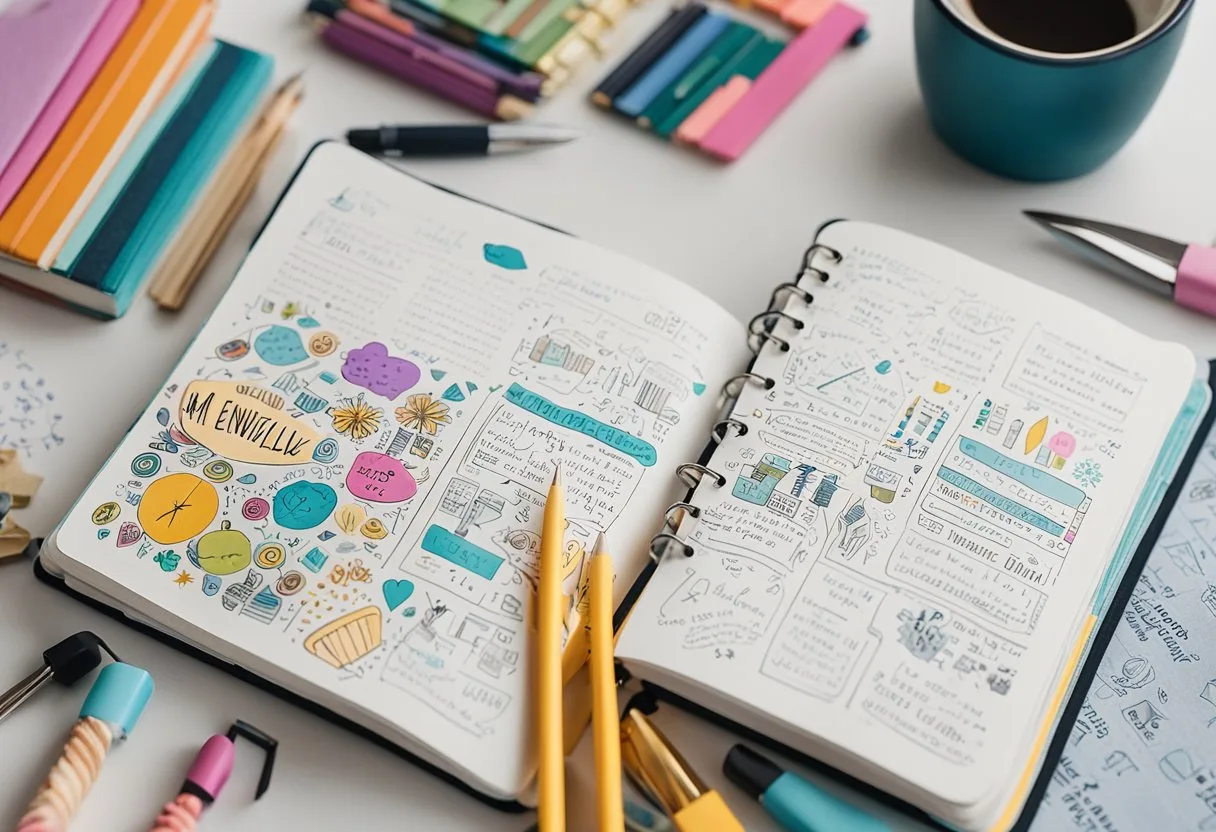Bullet journaling is a popular system of organization and planning that has gained a lot of attention in recent years. Developed by Ryder Carroll, the bullet journal (or “bujo” for short) is a customizable system that allows individuals to keep track of their daily tasks, goals, and ideas in a simple and efficient way. The beauty of the bullet journal is that it can be tailored to fit the needs of each individual user, making it a versatile tool for anyone looking to improve their organization and productivity. In this blog post, I will provide you a step by step guide to help you set up bullet journal with eaase.
Getting Started with Your Bullet Journal
When it comes to starting a bullet journal, the first thing you need to do is choose the right notebook. It is important to choose a notebook that suits your needs and preferences. A notebook with a hardcover is recommended, as it will help protect your pages from damage.
Choosing the Right Notebook
The notebook should have a good quality paper that can hold different types of pens, such as fine liners, gel pens, and brush pens. It is important to consider the size of the notebook as well. A5 size is the most common size used for bullet journals, but you can choose any size that is comfortable for you.
Essential Supplies
Once you have your notebook, you will need some essential supplies to get started. The most important supply is a pen. A fine liner pen is recommended, as it can be used for both writing and drawing. You can also use different colored pens or highlighters to add some color to your pages.
Other supplies you might need include a ruler, a pencil, an eraser, and some washi tape. Washi tape is a decorative tape that can be used to add some color and design to your pages. It is important to keep in mind that you do not need to buy all of these supplies at once. Start with the basics and add more supplies as you go along.
The Bullet Journal Framework
The Bullet Journal method is a flexible and customizable system that can be adapted to suit individual needs. The framework consists of four main components: the Index page, the Future Log, the Monthly spreads, and the Daily Logs.
Index Page Setup
The Index page is the first page of the bullet journal and serves as a table of contents. It helps to keep track of different collections and pages in the journal. To set up the index page, one can either number each page or use a pre-numbered journal. Then, create a list of topics and corresponding page numbers for easy navigation.
Future Log Creation
The Future Log is a place to record upcoming events, appointments, and tasks that are scheduled beyond the current month. To create a future log, divide the page into six or twelve sections, depending on the length of the journal. Label each section with the name of a month, and then list the events or tasks under the corresponding month.
Monthly Spread Organization
The Monthly spread is an overview of the month ahead, including important dates and tasks. To set up a monthly spread, start by creating a calendar with the days of the month. Then, add a section for tasks, events, and notes. One can also include a habit tracker or a mood tracker to monitor progress over time.
Daily Logs and Rapid Logging
Daily Logs are used to record tasks, events, and notes for each day. Rapid Logging is a shorthand method used to quickly capture information. To create a Daily Log, start by writing the date at the top of the page. Then, list the tasks and events for the day using bullets, dashes, or circles. One can also use signifiers such as a star to indicate priority or an exclamation point to indicate urgency.
The Bullet Journal framework is a versatile system that can be adapted to suit individual needs. By setting up an Index page, Future Log, Monthly spreads, and Daily Logs, one can stay organized and focused on achieving their goals.
How to set up bullet journal
Here’s a step-by-step guide to setting up a bullet journal:
- Materials: Begin with a notebook that suits your needs (dotted, lined, or plain) and a pen. Some people also like to use other stationery like highlighters, washi tape, or stickers for decoration.
- Key: Your bullet journal key is a legend that defines the symbols you’ll use to categorize entries. Common symbols include dots for tasks, circles for events, and dashes for notes. You can also create symbols for prioritization, such as stars for important tasks.
- Index: The first few pages of your bullet journal will serve as the index. Number your pages and list the contents as you create them, along with their page numbers. This helps you quickly find different sections.
- Future Log: This spread is used to log events or tasks that are several months away. Create a section for each month of the year, and as dates become known, jot them down in the corresponding month’s section.
- Monthly Log: At the start of a new month, create a monthly log. This includes a calendar and a task list. The calendar gives an overview of the month, and the task list is for items you want to accomplish during the month.
- Weekly/Daily Log: Decide if you want to plan your time by the week or day. Weekly logs provide an overview of the week ahead, while daily logs are more detailed. Include tasks, events, and notes as they come up.
- Collections: These are thematic lists or trackers, such as books to read, workout logs, or project plans. Start a new collection on a fresh page and add it to your index.
- Migration: At the end of the month, review your tasks. Migrate incomplete tasks to the next month or future log if they’re still relevant. This process keeps your journal up to date and helps you focus on priorities.
- Customization: Personalize your bullet journal with colors, doodles, or stickers. Some people like to add quotes, drawings, or use different colors to code different types of entries.
- Review and Reflect: Regularly review your bullet journal to assess what’s working and what’s not. Over time, you’ll refine your system to better suit your needs.
Remember, the bullet journal is a flexible system designed to be customized. Don’t be afraid to experiment with different layouts and structures until you find what works best for you.

Customizing Your Bullet Journal
Bullet journals are a highly customizable form of journaling that allow users to personalize their journal to their unique needs and preferences. Customizing your bullet journal can help you stay motivated and engaged with your journaling practice. Here are some ways to personalize your bullet journal:
Personalizing with Collections
One of the most popular ways to customize a bullet journal is by creating collections. Collections are pages dedicated to specific topics or themes. They can be used to track goals, plan projects, or simply to express creativity. Some popular collections include:
- Habit Tracker: A habit tracker is a page where you can track your daily habits. This can help you stay accountable and motivated to stick to your goals.
- Mood Tracker: A mood tracker is a page where you can track your moods over time. This can help you identify patterns and triggers that affect your mental health.
- Gratitude Log: A gratitude log is a page where you can write down things you are grateful for. This can help you cultivate a positive mindset and reduce stress.
- Meal Plan: A meal plan is a page where you can plan out your meals for the week. This can help you save time and money, and make healthier choices.
- Sleep Tracker: A sleep tracker is a page where you can track your sleep patterns. This can help you identify factors that affect your sleep quality and make changes to improve it.
Incorporating Trackers and Logs
Another way to customize your bullet journal is by incorporating trackers and logs into your daily or weekly spreads. These can help you stay organized and focused on your goals. Some popular trackers and logs include:
- Habit Trackers: Habit trackers can be added to your daily or weekly spreads to help you track your progress towards your goals.
- Mood Trackers: Mood trackers can be added to your daily or weekly spreads to help you track your moods over time.
- Sleep Logs: Sleep logs can be added to your daily or weekly spreads to help you track your sleep patterns.
- Gratitude Logs: Gratitude logs can be added to your daily or weekly spreads to help you cultivate a positive mindset.
- Meal Logs: Meal logs can be added to your daily or weekly spreads to help you track your eating habits.
Advanced Techniques and Tips
Migration and Reflection
One of the most important aspects of bullet journaling is the ability to reflect on past entries and migrate tasks that were not completed. This allows for a continuous improvement process and helps to ensure that important tasks are not forgotten.
A useful technique for migration is to create a monthly migration page where all incomplete tasks from the previous month are listed and then migrated to the current month’s task list. This ensures that nothing falls through the cracks and helps to maintain productivity.
Reflection is also an important aspect of bullet journaling. Taking the time to reflect on past entries can provide insight into patterns and habits that may be hindering productivity or causing stress. A useful technique for reflection is to create a monthly reflection page where the user can write down their thoughts and feelings about the previous month’s entries. This can help to identify areas for improvement and provide motivation for continued progress.
Design and Layout Ideas
Bullet journaling is not just about productivity, it can also be a creative outlet. Design and layout ideas can help to inspire creativity and make the bullet journaling experience more enjoyable. Some popular design and layout ideas include using different colors and fonts, creating themed pages, and incorporating illustrations or doodles.
Flexibility is a key aspect of bullet journaling, and users are encouraged to experiment with different layouts and designs until they find what works best for them. Some users prefer a minimalist approach, while others enjoy a more elaborate design. The cover page is also an important aspect of the bullet journal, as it sets the tone for the rest of the journal.
The key to successful bullet journaling is finding what works best for the individual user. By experimenting with different techniques and designs, users can create a personalized system that meets their unique needs and helps them to achieve their goals.

Bullet Journal for Productivity
Bullet journaling is a great way to boost productivity and stay organized. By using a bullet journal, individuals can manage their tasks, appointments, and deadlines in a systematic and effective manner. In this section, we will discuss how bullet journaling can improve productivity and provide tips on how to set up a bullet journal for maximum efficiency.
Setting Goals and Deadlines
One of the most important aspects of bullet journaling for productivity is setting goals and deadlines. By setting clear and achievable goals, individuals can prioritize their tasks and focus on what is most important. Setting deadlines for each task can help individuals stay on track and avoid procrastination.
To set goals and deadlines effectively, individuals should create a monthly task list and a to-do list for each day. The monthly task list should include all the tasks that need to be completed in a particular month, while the daily to-do list should include the tasks that need to be completed on a given day. This will help individuals stay organized and ensure that they are making progress towards their goals.
Managing Tasks and Appointments
Another important aspect of bullet journaling for productivity is managing tasks and appointments. By keeping track of all tasks and appointments in one place, individuals can avoid double-booking and ensure that they are using their time effectively.
To manage tasks and appointments effectively, individuals should create a schedule for each day and prioritize their tasks based on urgency and importance. They can also use symbols such as asterisks or exclamation marks to indicate tasks that are urgent or high-priority. This will help individuals stay focused and ensure that they are completing tasks in a timely manner.
Bullet journaling is a great way to boost productivity and stay organized. By setting clear goals and deadlines, and managing tasks and appointments effectively, individuals can make the most of their time and achieve their goals.
Frequently Asked Questions
What are the essential components to include when starting a bullet journal?
When starting a bullet journal, it is important to include a key or legend, an index, future log, monthly log, and daily log. These components will help you stay organized and productive. The key or legend will help you keep track of different symbols and their meanings.
The index will help you locate specific pages quickly. The future log will help you plan for future events, while the monthly log and daily log will help you keep track of your tasks and events for the current month and day.
How can I create an effective bullet journal layout?
To create an effective bullet journal layout, it is important to first consider your needs and preferences. You can use different layouts, such as a weekly layout, daily layout, or a combination of both. Use symbols and colors to help you stay organized and make your journal more visually appealing. You can also use trackers and collections to help you track your progress and keep track of important information.
What are some creative bullet journal spread ideas?
Some creative bullet journal spread ideas include mood trackers, habit trackers, gratitude logs, reading logs, and meal planners. You can also include inspirational quotes, doodles, and stickers to make your journal more fun and personalized.
How do I use a bullet journal to improve productivity and organization?
To use a bullet journal to improve productivity and organization, it is important to set goals, prioritize tasks, and track your progress. Use symbols to indicate the level of priority for each task and track the time you spend on each task. Use the index to keep track of important information and the future log to plan for future events.
What are the best practices for maintaining a bullet journal index?
To maintain a bullet journal index, it is important to keep it updated and organized. Use clear and concise descriptions for each page and use page numbers to make it easier to locate specific pages. Use different colors or symbols to indicate different types of pages, such as collections or trackers.
Can you provide examples of how to use a future log in a bullet journal?
A future log can be used to plan for future events, such as birthdays, holidays, or vacations. You can also use it to track long-term goals and projects. To use a future log, create a spread for each month and write down the events or goals that you want to accomplish. You can also include a section for notes or ideas for future events or projects.




